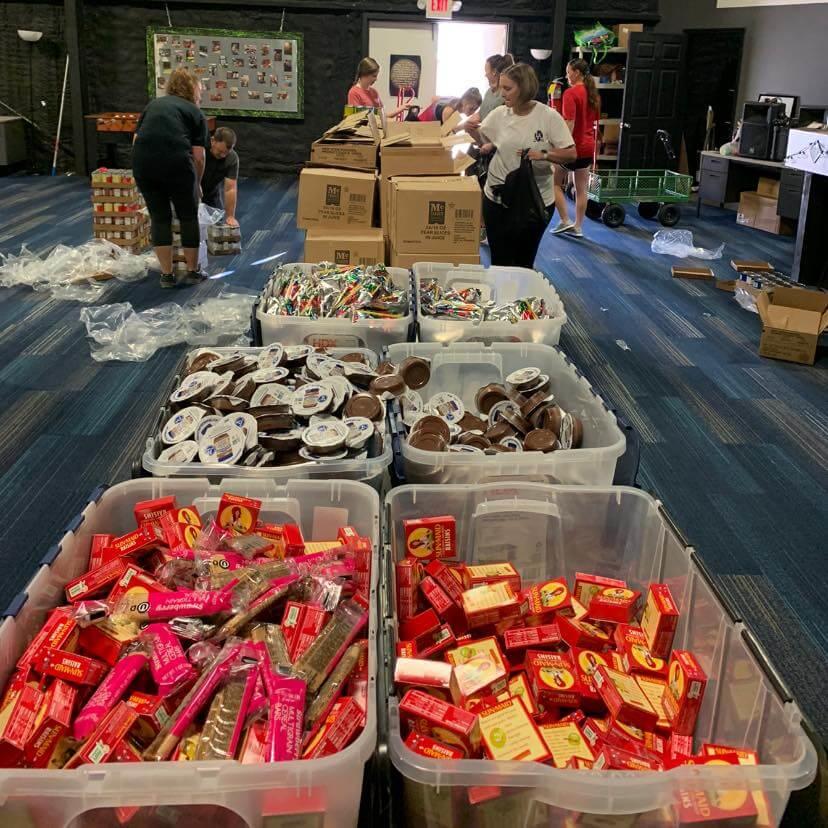
Caption
A March 2023 study from the Urban Institute found that almost 25% of American adults are food insecure, up five percentage points from a year earlier.
Credit: Deborah Myers

A March 2023 study from the Urban Institute found that almost 25% of American adults are food insecure, up five percentage points from a year earlier.
Since last summer, thousands of Georgians have turned to food banks, kitchens and shelters in order to make up for the loss of extra federal food stamp benefits that kept them from going hungry during the worst of the pandemic.
As the summer break approaches, Georgia’s food banks and other nonprofits are bracing for a surge in demand as children and teenagers have fewer places to eat meals while out of school. States across the country are seeing families become increasingly dependent on food banks for meals as families cope with a reduction in government food assistance.
The extra Pandemic-EBT benefits through the federal Supplemental Nutrition Assistance Program (SNAP), formerly known as food stamps, has been unavailable to more than 770,000 Georgians since June, resulting in as much as a 40% lower grocery shopping budget for many low-income families.
Feeding Georgia, the statewide food bank association, already struggled to cope with a 30% spike in food insecurity in 2021, the year after COVID-19 broke out.
Long before this spring, Georgia became one of the states that ceased to provide enhanced SNAP benefits after state officials declined to apply for an extension of the program into the current school year.
In March, another 32 states ended the Pandemic-EBT program, which provided millions of families with an extra monthly food allowance.
An extension of the program would provide an extra $290 million in food assistance to 1.1 million children across the state who qualify for free- or reduced-price school lunch.
In the wake of the loss of emergency food benefits, other government resources are being allocated to food banks in Georgia in order to alleviate hunger pains. This includes the state awarding federal funds to America’s Second Harvest of Coastal Georgia, the Atlanta Community Food Bank, and the Georgia Mountain Food Bank totaling $38 million.
More Georgians statewide received extra benefits since the program was first expanded in 2020 as part of the American Rescue Act. But there have been some bureaucratic hiccups along the way. Putting together a plan for the added pandemic while aid agencies also handled other assistance programs became a growing burden over the last year, leaving many state SNAP administrators overworked.
In 2021, the demand on food banks had slowly weakened compared to 2020 but still remained 30% higher than pre-pandemic level.
As inflation has pushed up prices on food and other necessities, the pandemic-era SNAP assistance for Georgians was expected to drop by about $120 million, according to the left-leaning Georgia Budget and Policy Institute.
Millions of lower-income people, primarily Black and Hispanic were able to reduce their poverty level as a result of the extra government funding, however the two minority groups still were at greater risk of hunger than whites adults, according to a study conducted by the Urban Institute. In its March report, the Washington, D.C.–based think tank found that almost 25% of American adults are food insecure, up five percentage points from a year earlier.
Between December 2021 and December 2022, food prices across the nation increased an average of 10.4%, the highest increase in decades, the study found.
“Although investments in federal nutrition programs and other federal aid during the COVID-19 pandemic helped mitigate hunger, families contended with a new economic stressor in 2022: food price inflation,” the report stated. “Many households have experienced food hardship as fewer public resources provided as COVID-19 pandemic aid expires and stricter budgeting needed for groceries, food hardship has increased for many households across the country.
“The share of adults reporting household food insecurity increased sharply between 2021 and 2022, erasing reductions in food insecurity that occurred following safety net policy changes during the first two years of the COVID-19 pandemic,” the report said.
Various organizations in Georgia will relieve some of the strain on regional food banks this summer by offering free meals at sites such as schools, libraries, churches and summer camps.
Georgia families can find meals this summer at various sites through The Seamless Summer Option and Happy Helpings, administered by local school districts and the state Department of Early Care and Learning.
According to Feeding America, one out of seven children in Georgia faces hunger, which means 360,000 children rely on government assistance and nonprofit organizations for their daily meals.
But Feeding America notes that charitable programs are unable to fully meet the demands of food insecurity and that the combination of charity and government assistance programs are necessary to help bridge the meal gap.
The Atlanta Community Food Bank reports that 38% of Georgians who are food insecure do not qualify for assistance because their earnings are above the federal poverty level. The federal poverty level for individuals in 2023 is an income of $14,580.
Besides government funding, food banks and their community partners continue to receive support from donors and corporate sponsors.
This story comes to GPB through a reporting partnership with Georgia Recorder.